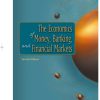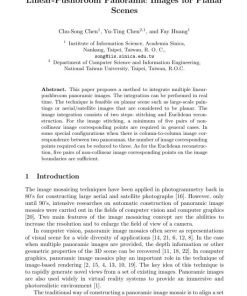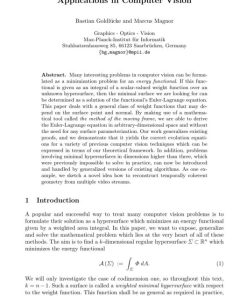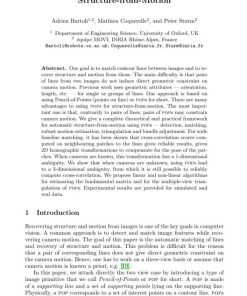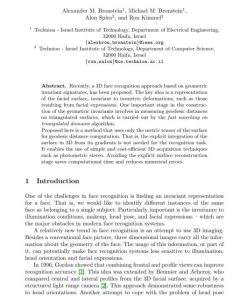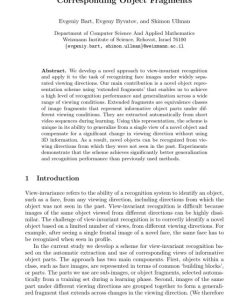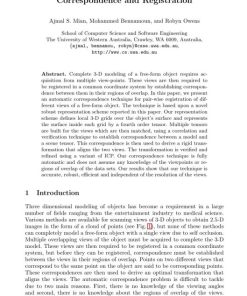Weak Hypotheses and Boosting for Generic Object Detection and Recognition 1st edition by Opelt, Fussenegger, Pinz, Auer ISBN 3540219835 9783540219835
$50.00 Original price was: $50.00.$25.00Current price is: $25.00.
Authors:A. Opelt, M. Fussenegger, A. Pinz; P. Auer , Tags:Computer Vision – ECCV 2004 , Author sort:A. Opelt, M. Fussenegger, A. Pinz & Auer, P. , Languages:Languages:eng , Published:Published:Mar 2004
Weak Hypotheses and Boosting for Generic Object Detection and Recognition 1st edition by A. Opelt, M. Fussenegger, A. Pinz, P. Auer – Ebook PDF Instant Download/Delivery. 3540219835, 978-3540219835
Full download Weak Hypotheses and Boosting for Generic Object Detection and Recognition 1st Edition after payment
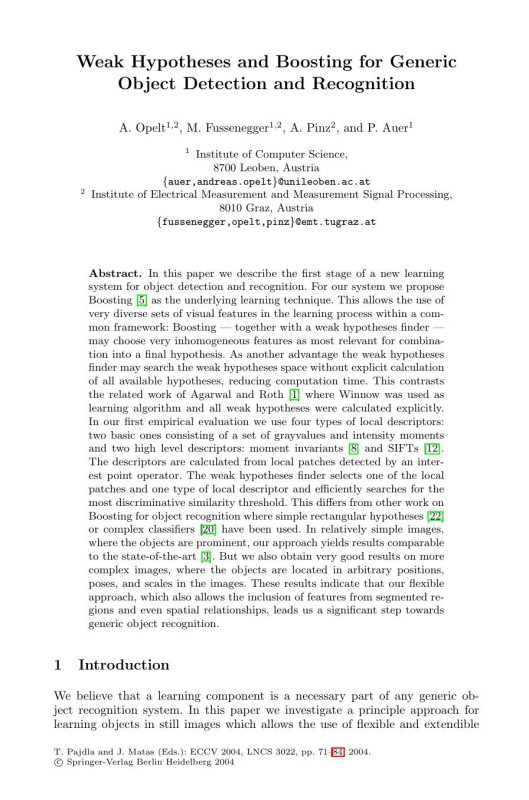
Product details:
ISBN 10: 3540219835
ISBN 13: 978-3540219835
Author: A. Opelt, M. Fussenegger, A. Pinz, P. Auer
In this paper we describe the first stage of a new learning system for object detection and recognition. For our system we propose Boosting [5] as the underlying learning technique. This allows the use of very diverse sets of visual features in the learning process within a common framework: Boosting — together with a weak hypotheses finder — may choose very inhomogeneous features as most relevant for combination into a final hypothesis. As another advantage the weak hypotheses finder may search the weak hypotheses space without explicit calculation of all available hypotheses, reducing computation time. This contrasts the related work of Agarwal and Roth [1] where Winnow was used as learning algorithm and all weak hypotheses were calculated explicitly. In our first empirical evaluation we use four types of local descriptors: two basic ones consisting of a set of grayvalues and intensity moments and two high level descriptors: moment invariants [8] and SIFTs [12]. The descriptors are calculated from local patches detected by an interest point operator. The weak hypotheses finder selects one of the local patches and one type of local descriptor and efficiently searches for the most discriminative similarity threshold. This differs from other work on Boosting for object recognition where simple rectangular hypotheses [22] or complex classifiers [20] have been used. In relatively simple images, where the objects are prominent, our approach yields results comparable to the state-of-the-art [3]. But we also obtain very good results on more complex images, where the objects are located in arbitrary positions, poses, and scales in the images. These results indicate that our flexible approach, which also allows the inclusion of features from segmented regions and even spatial relationships, leads us a significant step towards generic object recognition.
Weak Hypotheses and Boosting for Generic Object Detection and Recognition 1st Table of contents:
-
Introduction
- 1.1 Background and Motivation
- 1.2 Challenges in Generic Object Detection and Recognition
- 1.3 Role of Weak Hypotheses in Boosting
- 1.4 Objectives and Contributions of the Paper
- 1.5 Structure of the Paper
-
Related Work
- 2.1 Overview of Object Detection and Recognition Techniques
- 2.2 Use of Weak Hypotheses in Machine Learning
- 2.3 Boosting Algorithms: AdaBoost, RealBoost, and Others
- 2.4 Weak Learners in Object Detection
- 2.5 Limitations and Gaps in Current Approaches
-
Preliminaries
- 3.1 Definition of Weak Hypotheses
- 3.2 Basic Principles of Boosting and Ensemble Learning
- 3.3 Overview of Object Detection and Recognition Tasks
- 3.4 Evaluation Metrics for Object Detection and Recognition
-
Weak Hypotheses for Object Detection and Recognition
- 4.1 What Makes a Weak Hypothesis? Characteristics and Examples
- 4.2 Types of Weak Classifiers: Decision Stumps, Simple Features, and Thresholds
- 4.3 Designing Weak Hypotheses for Generic Object Classes
- 4.4 Combining Weak Hypotheses to Form Stronger Classifiers
- 4.5 Limitations and Challenges of Using Weak Hypotheses in Detection
-
Boosting Algorithms for Object Detection
- 5.1 Overview of Boosting and Its Role in Object Detection
- 5.2 AdaBoost and Its Variants
- 5.3 RealBoost and Other Boosting Methods for Object Recognition
- 5.4 Adaptive Boosting for Multi-Class Detection Problems
- 5.5 Boosting and Feature Selection for Object Recognition
-
Algorithm Design and Implementation
- 6.1 Overview of the Proposed Boosting Framework for Object Detection
- 6.2 Learning Weak Hypotheses from Training Data
- 6.3 Boosting Procedure: Training, Weight Updates, and Iterative Refinement
- 6.4 Computational Efficiency and Optimization for Large Datasets
- 6.5 Real-Time Detection Considerations
-
Experimental Setup and Evaluation
- 7.1 Datasets for Object Detection and Recognition
- 7.2 Evaluation Metrics: Detection Accuracy, Precision, Recall, and F1 Score
- 7.3 Experimental Protocols and Cross-Validation Techniques
- 7.4 Comparison with State-of-the-Art Object Detection Methods
- 7.5 Performance Evaluation Across Different Object Categories
-
Results and Discussion
- 8.1 Visual Examples of Object Detection and Recognition
- 8.2 Quantitative Results: Comparison of Weak Hypotheses and Boosting Performance
- 8.3 Impact of Weak Learners on Overall Detection Accuracy
- 8.4 Analysis of Performance for Different Object Types and Conditions
- 8.5 Discussion on the Robustness of the Boosting Approach in Various Scenarios
-
Applications of Weak Hypotheses and Boosting
- 9.1 Object Detection in Robotics and Autonomous Vehicles
- 9.2 Face Detection and Recognition in Security Systems
- 9.3 Surveillance and Automated Monitoring Systems
- 9.4 Object Recognition in Augmented Reality
- 9.5 Applications in Medical Imaging and Diagnostics
-
Challenges and Future Directions
- 10.1 Scalability and Real-Time Performance in Large-Scale Detection
- 10.2 Generalization to New Object Classes and Unseen Data
- 10.3 Dealing with Complex Object Variability and Occlusions
- 10.4 Enhancing Weak Hypothesis Generation with Deep Learning Techniques
- 10.5 Future Research Directions in Boosting for Object Detection and Recognition
-
Conclusion
- 11.1 Summary of Key Contributions and Findings
- 11.2 Practical Implications of Boosting for Generic Object Recognition
- 11.3 Limitations and Open Problems
- 11.4 Final Remarks and Future Work
People also search for Weak Hypotheses and Boosting for Generic Object Detection and Recognition 1st:
weak hypothesis example
hypothesis boosting problem
bootstrap hypothesis testing example
do weak bases dissociate
efficient market hypothesis weak form



